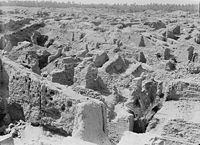Yesterday, we suggested that the obliteration of archaeological treasures in Iraq was on our mind because of a story in the Guardian about an upcoming exhibition at the British Museum. The show will document the predations on Iraq’s rich archaeological sites, primarily the ruins of Babylon, by U.S. and UK forces since the beginning of the invasion of Iraq. The extent of the losses will probably never be known — how could it when you are filling sandbags from ground from the strata that holds the fragmentary artifacts at a base you’ve established right next to the site of ancient Babylon?
“It’s a tragedy of the highest cultural consequence unfolding before us and nobody is caring,” said (Dan)Cruickshank (architecture historian). “The British Museum is absolutely right to raise this issue. We need to debate what is happening to this place and the 10,000 other archaeological sites across Iraq that have not been fully documented and recorded.”
If the occupiers of Iraq were to respond to these charges, I’m sure they’d simply say that, well, they’ve done their best, and, really, aren’t bigger issues at stake? This rhetorical question inevitably trumps any list of destroyed objects, trashed sites, pulverized architecture. Aren’t there bigger issues at stake? Presumably, they mean “democracy” but perhaps we suspect “geo-political advantage in a region also rich in oil.”
But what happens if we conduct a little thought experiment: What if our foreign policy was built on the preservation and support of art-making? What sort of approaches and decisions would we have made? Would this new principle guide us more effectively than the old one(s)?

Just to give our argument some backbone, we turn to John Dewey (of course!), whose Art as Experience is in some ways one long argument for the centrality in human life of “aesthetic experience.” (We’ve linked before to this excellent site on Dewey’s aesthetic ideas The key word for our purposes is “centrality.” And though Dewey defines aesthetic experience broadly, he is not talking about geo-political advantage.
OK, to the case in question. What would have been the result if we based our approach to Saddam’s Iraq (or any Iraq) on 1) the discovery, preservation and broadcast of Babylonian artifacts/civilization 2) ditto the art of later periods (Baghdad has been a rich city for a long time, after all) 3) support for current art-making? We certainly wouldn’t have invaded the place, and I suspect our concern for Iraqi (we could pause for a quick argument about the artificiality of “Iraq” here but we won’t) culture might have had a powerful effect on how it was governed. Nothing unites us with someone else more than the fact that they treasure what we treasure. We might have even worked out fair oil agreements in all the bonhomie.
On the other hand, once the Taliban made clear their intention to destroy the great Buddhas of Bamyan in 2001, then an intervention would have been necessary. In short, we would have invaded the right country before the terrorist attacks on the U.S. later that year. But, who knows, maybe the conditions that made Osama bin Laden possible in the first place would not have existed. Imagine if U.S. policy in the Middle East was based on the preservation of archaeological sites (including temples and mosques) in the region? From that position we might have served as honest brokers of peace: War is the enemy of artifacts.
 Am I serious about this? I’m becoming more serious every day. I like the indirection of the approach. Saddam, let us help you develop the great site at Babylon so that all may see the greatness therein. Likud and Hamas, let’s start by making sure your holy sites are out of harm’s way and celebrate them together. We would like our scholars and artists to be able to study what you have made, our people to appreciate your art. It re-values the place as a whole, unites it into an aesthetic whole. Which, as Dewey points out, is one of the achievements of art — to integrate various elements, to turn tension into harmony. This is more than a metaphor to Dewey; it is our actual experience of aesthetic practice; it makes human life special.
Am I serious about this? I’m becoming more serious every day. I like the indirection of the approach. Saddam, let us help you develop the great site at Babylon so that all may see the greatness therein. Likud and Hamas, let’s start by making sure your holy sites are out of harm’s way and celebrate them together. We would like our scholars and artists to be able to study what you have made, our people to appreciate your art. It re-values the place as a whole, unites it into an aesthetic whole. Which, as Dewey points out, is one of the achievements of art — to integrate various elements, to turn tension into harmony. This is more than a metaphor to Dewey; it is our actual experience of aesthetic practice; it makes human life special.
So, by all means: Viva Babylon! The great Ishtar gate (above, currently ensconced in the Pergamon Museum in Berlin), the Etemenanki ziggurat (destroyed by Alexander, who intended to rebuild it, but never did), the Hanging Gardens of Nebuchadnezzar!
Note: Photos from Wikipedia — top: a detail of the Ishtar gate; middle: mural of of Babylon near the Ishtar gate, circa 600 BC; bottom: Babylon in 1932.